Disaster recovery (DR) is a cornerstone of business continuity. In today’s fast-paced world, disruptions such as natural disasters, cyberattacks, or system failures are not just possible; they are likely.
The ability to swiftly resume operations can spell the difference between a company thriving or facing significant setbacks. Technology plays a pivotal role in this recovery process, enabling businesses to minimize downtime and prevent data loss.
Modern advancements in DR solutions ensure that companies can bounce back quickly, maintaining their operations and safeguarding their reputation. Let’s find out more about these solutions and how they can benefit your business in the event of a disaster.
The Nuts and Bolts of Disaster Recovery
Disaster recovery encompasses a comprehensive set of policies, tools, and procedures designed to restore essential technology infrastructure and systems after a disaster. The primary objective is to minimize downtime and data loss, which are vital for maintaining business operations and credibility. Effective DR strategies include robust data backup solutions, system redundancy, and clear communication protocols to facilitate quick and efficient recovery. Regular testing and updates are integral to the success of these plans, ensuring preparedness when disaster strikes.
The Evolution of Disaster Recovery Solutions
Disaster recovery solutions have evolved significantly over the years. Traditional methods involved manual processes, such as maintaining physical backups and transporting them to offsite storage facilities. While effective, these methods were time-consuming and prone to human error. Technological advancements have revolutionized DR solutions, making them more automated and reliable. Innovations such as cloud computing, virtualization, and real-time data replication offer scalable, flexible, and efficient options that reduce recovery time and enhance data protection. Businesses now have access to sophisticated tools that ensure continuity and resilience.
Cloud-Based Disaster Recovery
Cloud technology has transformed disaster recovery. Cloud-based DR solutions provide scalable, cost-effective, and flexible options for businesses of all sizes. By leveraging cloud services, companies can back up their data in real-time, ensuring that they have the most up-to-date information available when needed. One significant advantage of cloud-based DR is the ability to replicate data and applications across multiple geographic locations. This geographic redundancy ensures that if one data center is affected by a disaster, the data can still be accessed from another location, minimizing downtime.
Real-Time Data Replication and Backup
Real-time data replication continuously copies data to ensure a secondary location has an exact copy of the data in near real-time. This process reduces the risk of data loss and ensures that the most current data is available during recovery. Tools like Smallpdf’s PDF to Word converter exemplify the efficiency modern tools provide. Such tools can be crucial during recovery by allowing quick access to and conversion of important documents, ensuring that business operations can continue without significant delays.
Virtualization Technologies
Virtualization technology allows businesses to create virtual versions of physical resources, such as servers and storage devices. Virtualization enhances disaster recovery by enabling the creation of virtual environments that can be quickly activated if physical resources are compromised. For instance, in a disaster scenario, a company can quickly spin up virtual servers and storage to replace affected physical infrastructure. This capability significantly reduces recovery time and ensures that business-critical applications remain operational.
Automated Disaster Recovery Solutions
Automation is a key trend in modern disaster recovery. Automated DR solutions can initiate recovery processes without human intervention, ensuring a faster and more reliable response. These solutions often include predefined workflows and scripts that can automatically detect issues, initiate data replication, and even switch to backup systems. For example, automated failover systems can detect a server failure and automatically redirect traffic to a backup server, ensuring minimal disruption to services.
The Role of AI and Machine Learning in Disaster Recovery
Artificial intelligence (AI) and machine learning (ML) are transforming disaster recovery solutions by providing advanced capabilities that enhance preparedness and response. These technologies can analyze extensive datasets to predict potential failures and suggest proactive measures, ensuring businesses can prevent disasters before they occur. By leveraging AI and ML, companies can achieve a higher level of resilience and operational continuity, minimizing downtime and financial losses.
Predictive Analytics
Predictive analytics utilizes historical and real-time data to forecast future events. In disaster recovery, it identifies patterns and trends that may signal an impending system failure or security breach. For instance, if a system shows signs of unusual activity that previously led to a failure, predictive analytics can alert IT teams to intervene before a catastrophe occurs. This pre-emptive approach not only prevents downtime but also protects sensitive data and maintains business integrity. By continuously learning from new data, predictive analytics becomes increasingly accurate, offering businesses a reliable tool for risk management.
Automated Incident Response
Automated incident response leverages AI to detect and address incidents in real-time, significantly speeding up response times. These systems can analyze the nature and severity of an incident, then execute predefined recovery protocols without human intervention. For example, if a cyberattack is detected, an AI-driven system can automatically isolate affected networks, initiate data backups, and notify security teams, all within seconds. This rapid response is crucial in mitigating damage, particularly in the face of sophisticated cyber threats. Automated incident response ensures that critical issues are addressed promptly, reducing the impact on business operations and protecting valuable assets.
Enhancing Disaster Recovery Planning with AI
AI and ML enhance disaster recovery planning by providing tools that can simulate various disaster scenarios, allowing businesses to test and refine their recovery strategies. These simulations help identify vulnerabilities in existing plans and provide insights into how different types of disasters might impact operations.
By understanding these potential impacts, businesses can develop more robust and comprehensive disaster recovery plans. AI can also help prioritize recovery efforts based on the criticality of different business functions, ensuring that the most important systems are restored first. This strategic approach maximizes efficiency and minimizes downtime during an actual disaster.
Technology is an essential component of effective disaster recovery. From cloud-based solutions and real-time data replication to AI-driven predictive analytics and automated incident response, modern DR technologies offer businesses the tools they need to ensure continuity and resilience.
By implementing a comprehensive disaster recovery plan and leveraging the latest technological advancements, businesses can protect themselves from disasters’ potentially devastating impacts and maintain operations in even the most challenging circumstances.
FAQ’s
What is business continuity?
Business continuity refers to an organization’s ability to maintain essential functions during and after a disaster. It involves planning and preparation to ensure that critical operations can continue with minimal disruption.
How does technology support business continuity?
Technology plays a crucial role in business continuity by providing tools and solutions such as data backup, cloud computing, cybersecurity measures, and automated systems that help maintain operations during disruptions.
Why is cloud computing important in disaster recovery?
Cloud computing is important because it allows organizations to store data and applications off-site, providing redundancy and accessibility. This reduces the risk of data loss and enables quick recovery from physical or cyber incidents.










